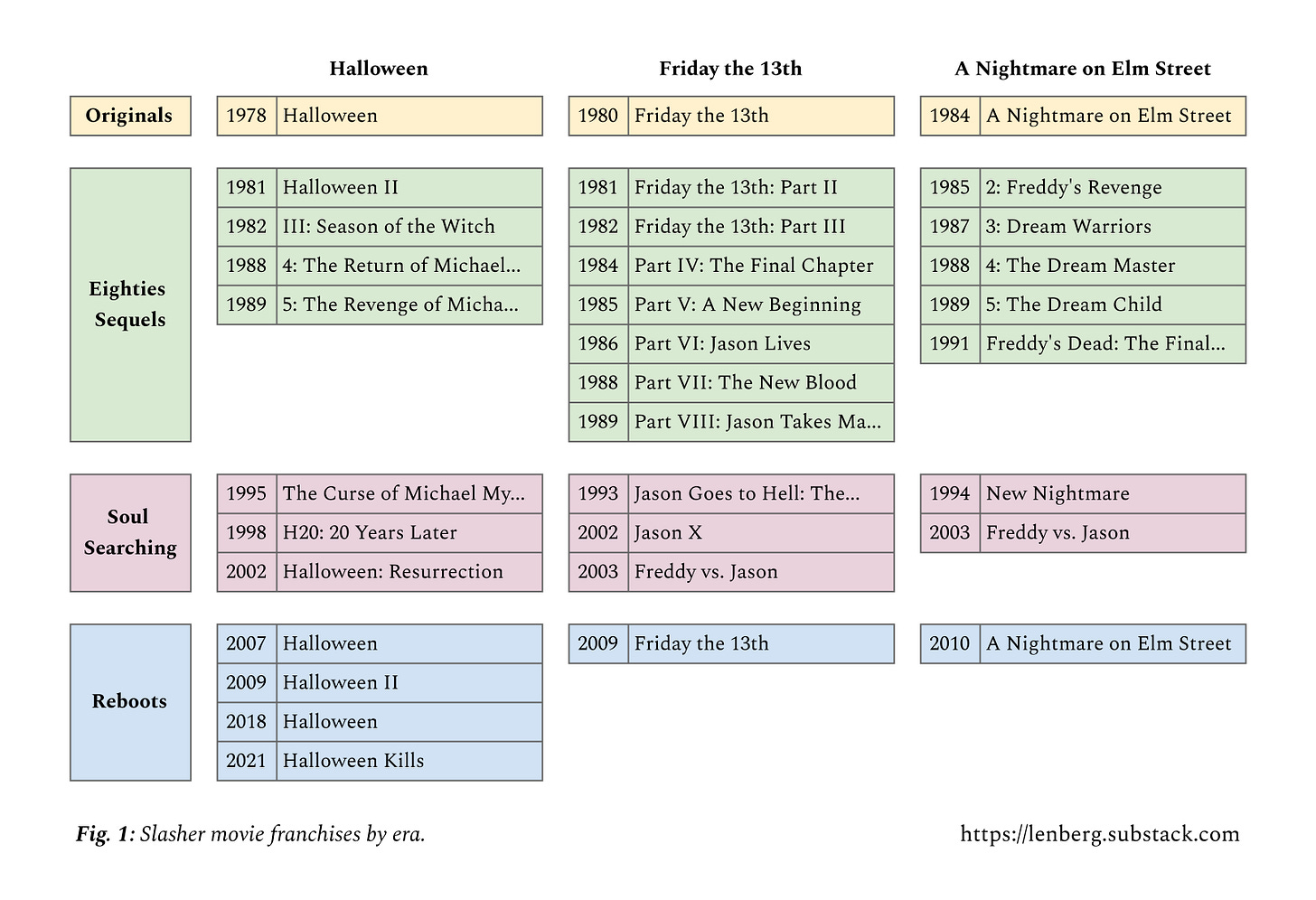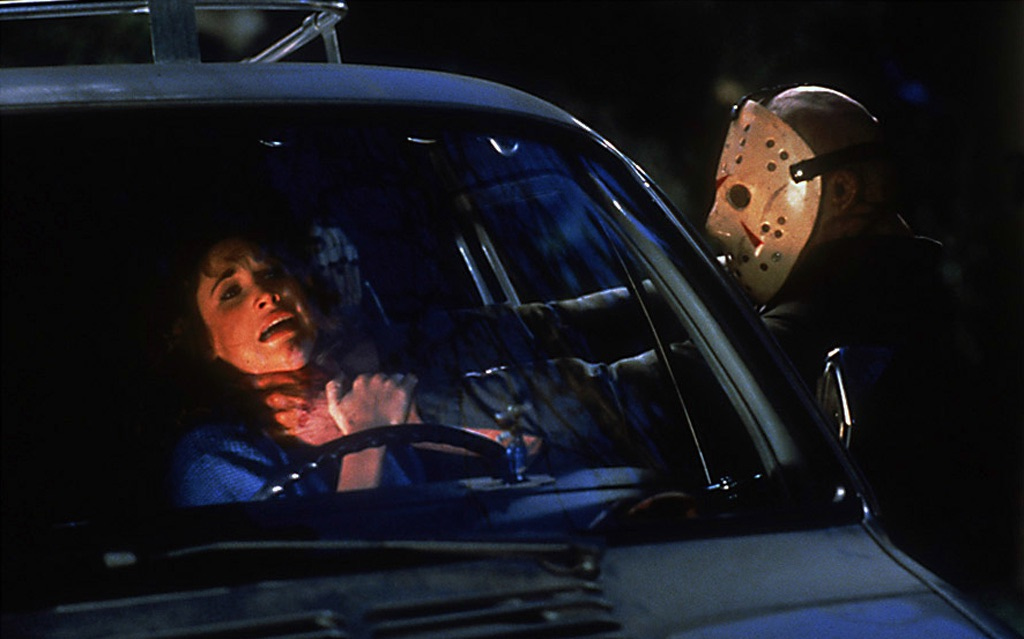I’ve recently been obsessed with the crunchiness of 80s movies. The now-flourishing 80s nostalgia industry uses several recognizable aesthetic signifiers for the decade: neon colors, music filled with synths and reverb-heavy drums, film grain or the low-quality sheen of early video, the hairstyles, the fashion. But the Netflix shows and the throw-back music videos don’t capture the crunchy, unmanicured aspects of 80s media, like the raw sleaziness, the over-the-top energy, or the straight-forward sincerity (read: cheesiness). Acting styles were beginning to happily embrace the artifice of movies, leaving behind the naturalistic acting sensibilities of the 70s.1
I think of the 80s as the primordial soup where America's current mainstream movie culture formed, a sort of petri dish for unashamed commercialization, the dominance of the sequel, and the development of several enduring genres of “low-brow” cinema, like hyper-masculine action, family movies driven by merchandising tie-ins, and low-budget horror.
My big movie-watching project for the first half of 2022 has been completing several horror movie franchises—more specifically “slasher" franchises—that originated in the 1980s.2 They feature some of the most iconic murderers in modern horror, characters I remember being described to me as a kid in terrifying and inaccurate detail, probably by someone who was older than me, or who had a cool older cousin.
Halloween follows Michael Myers, the masked psycho who stalks the suburbs looking for babysitters to stab. Friday the 13th follows Jason Voorhees, the hockey-mask-wearing, machete-wielding killer who hunts down sexually active summer camp counselors. A Nightmare on Elm Street follows Freddy Krueger, the repulsive dream-demon with a bladed glove who terrorizes teenage nightmares, seeking vengeance. Including all of the sequels, reboots, and legacy-quels from 1978 to now, these three properties have a combined total of 32 films, at least until the next Halloween movie comes out this October. They range from all-time classics and charming micro-budget productions to embarrassing flops and cynical, exploitative cash-grabs.
What follows are my (mostly) spoiler-free thoughts on the installments that stood out to me, for better or worse.
Best Films
Halloween (1978) has a well-deserved reputation as a masterpiece of horror. It creates a beautifully haunting atmosphere with drifting, hazy cinematography, gradually building tension, the good vibes of Laurie Strode (played wonderfully by a young Jamie Lee Curtis) and her friends, and the bad vibes of Michael Myers. Halloween had already perfected the basic elements of the slasher formula before the 1980s wave of slasher movies even began.
My favorite movie out of all of these franchises, though, is probably the original A Nightmare on Elm Street from 1984. It’s definitely a slasher—a stab-based murderer hunts down young, attractive victims one by one; there’s a final girl—but it adds the twist that the murderer lives in your dreams. The nightmare angle frees the movie to shake up the slasher formula and bring scares and kills to a variety of interesting locations and situations, both real and imagined. The main characters learn about the danger and try to fight back, which gives them a level of agency that the average slasher movie rarely does. Usually the main characters don’t even know they’re in a horror movie until the last ten minutes. A Nightmare on Elm Street isn’t perfect, but the bloody nightmare sequences are feats of horror filmmaking and miracles of special effects. It’s very fun to watch something made over 30 years ago that makes you think, “How did they do that!?”
The entire Nightmare on Elm Street series has reliably effective horror imagery and inventive dream situations. I enjoyed the third and fourth movies in the franchise almost as much as the first, and New Nightmare (1994) delivers on a great meta premise before the term “meta” even existed. Like any long-running franchise, it has its low points—a drawn-out sequence of Freddy controlling a victim trapped in a video game in Freddy’s Dead: The Final Nightmare (1991) comes to mind—but even the worst installments have some fresh ideas and infinitely more care put into them than the worst of Halloween and Friday the 13th.
Worst Film
In 1997, the hugely successful (and still great) horror-satire Scream identified and subverted the aging tropes of the slasher genre. By 2000, two more Scream movies had been released, and the (not great) Scary Movie was already parodying Scream. The classic slasher franchises, now out of fashion, would have trouble taking themselves seriously for a while. In 2002, Miramax—the studio behind both Scream and Scary Movie—released the eighth Halloween movie, Halloween: Resurrection. It’s a movie with no self-respect whatsoever.
It starts with a painfully bad prologue that could have won the award for “Clumsiest Explanation for Why the Previous Film’s Ending Didn’t Matter at All,” which is a crowded field for these franchises. Resurrection then follows a paper-thin plot about a reality TV/early-Internet live-stream event put on by a character (“character” is generous) played by rapper Busta Rhymes. There’s just no coming back from Busta Rhymes doing kung fu on Michael Myers. This was rock bottom for the Halloween franchise, and it’s my pick for the worst movie in the whole bunch.
Craziest Premise
The later Friday the 13th movies have some far-fetched premises. Part VII: The New Blood is basically Jason vs. generic-brand Carrie. Part VIII: Jason Takes Manhattan explores not only the question suggested by the title, “What if Jason went to New York City?” but also, “What would Jason get up to if he was on a big boat?” Freddy vs. Jason, the 2003 fan-service-fueled crossover with A Nightmare on Elm Street, asks, “What if Freddy versus Jason? And how?"
The winner here, though, is Jason X (2002). The premise is simple but elegant: Jason gets cryogenically frozen. Jason gets thawed out 400 years in the future, on a spaceship. Luckily for him, the spaceship is populated by his favorite machete fodder: sex-positive co-eds.
Best Reboot
After those lean years of the 90s and early 2000s—what I call the “Soul Searching Era" for the three franchises (see Figure 1)—all three properties were rebooted. The Friday the 13th and Nightmare reboots, released in 2009 and 2010, respectively, are basic modern updates to the old formulas with some interesting new elements. They both also throw in jarring, unnecessary 21st century scumminess that is far less charming than the old 80s sleaze.
Director Rob Zombie’s 2007 Halloween remake and his 2009 follow-up can’t be described as basic updates to the formula. The unswerving depiction of brutal, unrelenting violence makes these movies difficult to watch—the brutality feels almost avant-garde at points. They’re less interested in building tension and fear, like the original Halloween, and more interested in exploring the unexplainable nature of violence and the cause and effect of trauma. I’m not sure that I totally “get the point” of these two movies, but they are my favorite of these reboots because they are doing something totally new with the material and (at the risk of giving Rob Zombie too much credit) maybe something totally new with the horror genre.
Honorable Mention
Between my Nightmare and Halloween binge-watches, I watched the Scream movies. They are the clear successors to the big 80s slasher franchises. Scream (1997) rides the line between homage and satire perfectly. It’s a late-90s movie through and through, but it still feels more fresh than anything that the Big Three franchises have released since their heyday in the 80s, including the second wave of Halloween reboots that began in 2018. It’s hilarious, clever, genuinely scary at points, and filled with incredible comedic and melodramatic performances. I loved the entire Scream franchise, including the self-aware 2022 reboot/legacy-quel/self-described “requel” (though I hope their term doesn’t stick).3
Best Original Score
Each of these franchises has great music (though I guess I’m thinking of a sound effect for Friday the 13th—“kih-kih-kih, mah-mah-mah,” or whatever it is.) But there’s no real contest here. Nothing beats John Carpenter’s frenetic and eerie score for Halloween, with its unsettling 5/4 time signature and lo-fi simplicity. Carpenter, who also directed, co-wrote, and produced the first Halloween, said (I assume), “Well, we don’t have the budget for a real composer. I guess I’ll just crank out one of the most classic scores in horror movie history." I’ll leave you with his main theme.
Thanks for reading Len’s Blog! Subscribe if you’d like to get an email whenever I post something new here. (My current release schedule is undisclosed and highly irregular, but never more than once a month. Could you even imagine?)
For a helpful case study on this shift in acting styles, see Al Pacino’s career.
I wouldn’t have gotten far in this project without the great podcast “With Gourley and Rust,” which has covered each of these franchises, movie by movie. It’s a self-described “easy listening cozy-cast” featuring two very funny improvisers who have extremely laidback and friendly conversations about horror movies.
Besides the 2022 movie, every Scream was directed by Wes Craven, who also directed the original Nightmare on Elm Street and New Nightmare. I guess I’m a Wes Craven Head now.






